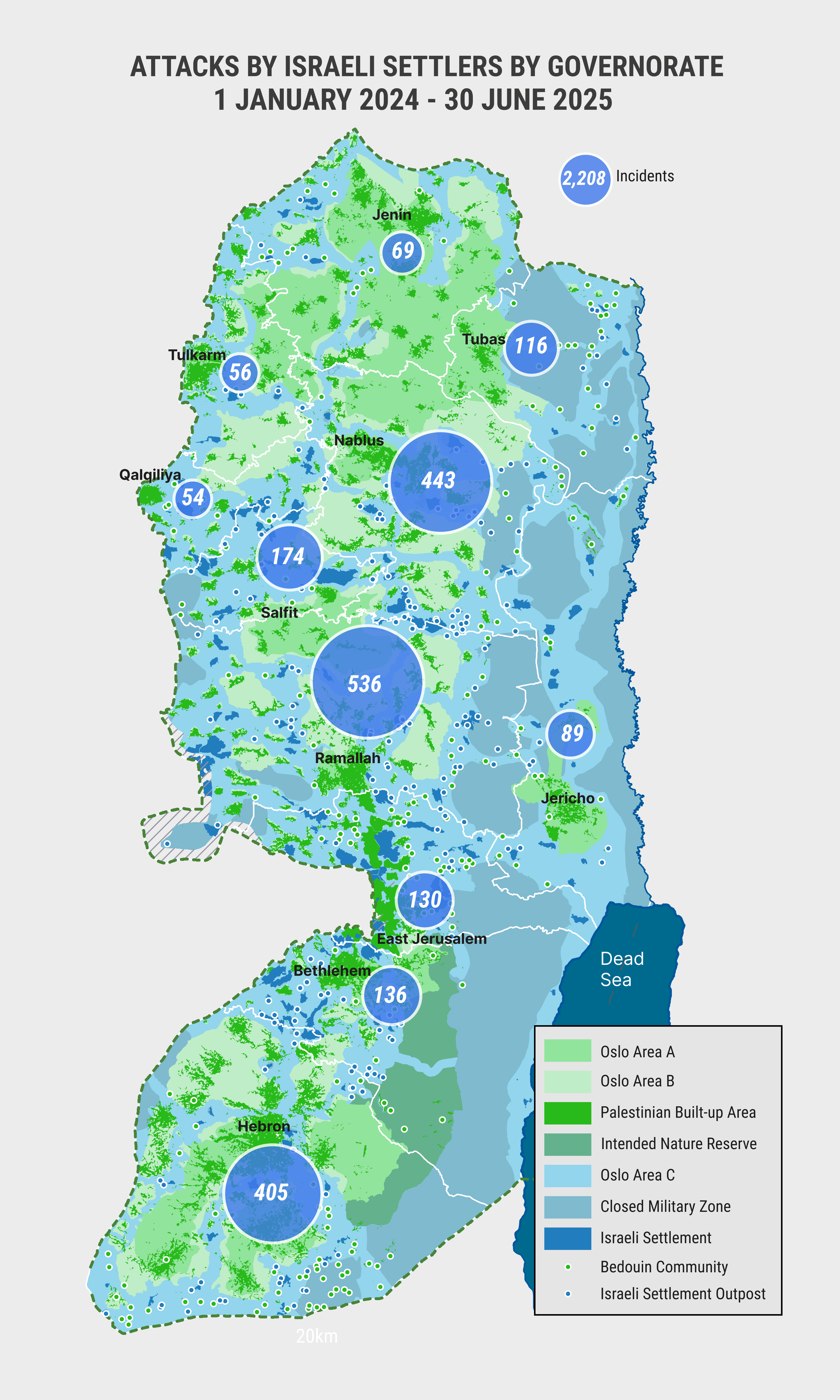Map of West Bank Attacks by Israeli Settlers


Alex Cartwright
Senior Cartographer & GIS Specialist
Alex Cartwright is a renowned cartographer and geographic information systems specialist with over 15 years of experience in spatial analysis and data...
Geographic Analysis
What This Map Shows
The visualization titled "West Bank Attacks by Israeli Settlers by Governate (January 2024 to June 2025)" provides a detailed geographical depiction of incidents involving violence attributed to Israeli settlers across various governates in the West Bank. This map, compiled by the UN Office for the Coordination of Humanitarian Affairs, highlights the frequency and distribution of such attacks, offering a critical insight into the complex socio-political landscape of the region. By focusing on the spatial patterns of these incidents, the map not only sheds light on where these attacks are most prevalent but also prompts discussions about the underlying causes and consequences of settler violence in this historically contested area.
Deep Dive into Israeli Settler Violence
Israeli settler violence has increasingly become a focal point in discussions about the Israeli-Palestinian conflict. As the settler population continues to grow in the West Bank, so too does the frequency of incidents involving aggression towards Palestinians, often fueled by tensions over land, resources, and historical grievances. The map illustrates that certain governates experience higher levels of violence, indicating that geography plays a significant role in this ongoing conflict.
Interestingly, the areas with the highest recorded attacks often overlap with regions that have seen significant settlement expansion. For instance, the governates of Hebron and Nablus stand out on the map, reflecting their strategic importance in the broader context of Israeli settlement policy. Hebron, home to both a substantial Palestinian population and a significant number of Israeli settlers, has been a flashpoint for violence, with numerous reported incidents of harassment and physical attacks on Palestinians. In fact, reports indicate that the presence of settlers in Hebron has a profound impact on daily life for the local Palestinian community, often restricting their movement and access to resources.
Furthermore, the map indicates that the violence is not uniformly distributed; rather, it tends to cluster around specific settlements or outposts, which are often viewed as provocateurs in the conflict. This clustering effect raises questions about the motivations behind such violence. Are these acts spontaneous expressions of frustration, or do they reflect a more organized strategy aimed at deterring Palestinian presence in contested areas?
Demographically, the settlers are predominantly Israeli Jews, many of whom believe in the ideological justification for settling in these territories. However, this belief system is often met with resistance from the Palestinian population, leading to a cycle of retaliation that exacerbates tensions. The impact of settler violence extends beyond immediate physical harm; it has long-term psychological effects on the Palestinian community, fostering fear and mistrust.
Regional Analysis
When analyzing the data presented in the map, it becomes apparent that the West Bank is marked by stark variations in violence levels across different governates. For instance, the governate of Ramallah exhibits a moderate level of settler violence, while the southern governate of Bethlehem may experience fewer attacks, likely due to its smaller settler population and different demographic dynamics.
In contrast, the northern governate of Jenin shows a disturbing trend of increasing violence in recent months, potentially linked to rising tensions and confrontations between settlers and local Palestinian residents. The map may indicate that areas with a higher presence of military checkpoints and security forces experience different patterns of violence compared to those with less oversight.
Moreover, the differences in violence levels can also be attributed to the presence of international observers and NGOs in certain regions. For example, areas with active monitoring by human rights organizations tend to report fewer incidents of violence, suggesting that visibility may deter aggressive actions by settlers. The interplay of these various factors illustrates the multifaceted nature of the conflict and the importance of context in understanding the patterns of violence.
Significance and Impact
The implications of settler violence in the West Bank go beyond immediate physical confrontations. This issue is deeply intertwined with the broader Israeli-Palestinian conflict, affecting peace negotiations, international relations, and humanitarian conditions on the ground. The ongoing violence has led to increased displacement among Palestinian communities, further complicating efforts towards achieving a lasting peace.
Current trends suggest that as settlement expansion continues, the likelihood of violence will also increase. If left unaddressed, this cycle of violence could escalate, leading to further destabilization in the region. Understanding these patterns through visualizations like the one presented in this map is essential for policymakers, researchers, and activists aiming to address the root causes of conflict and promote dialogue between affected communities.
In conclusion, the map serves as a crucial tool for visualizing the complex dynamics of settler violence in the West Bank. It not only highlights the areas most affected but also prompts critical discussions about the socio-political ramifications of such violence. By engaging with this data, we can better understand the urgent need for interventions that address both the immediate and underlying issues fueling this conflict.
Visualization Details
- Published
- October 4, 2025
- Views
- 46
Comments
Loading comments...